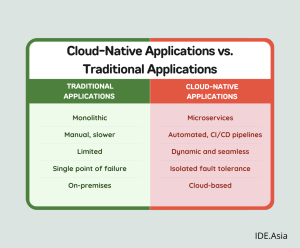What Are Cloud-Native Applications?
Cloud-native applications are software solutions specifically designed to run in cloud environments. Unlike traditional monolithic applications, cloud-native systems are built using microservices architecture, allowing them to be modular, scalable, and resilient.

This architectural approach empowers organizations to respond rapidly to market demands. For instance, teams can develop, deploy, and update individual microservices without affecting the entire application, leading to faster innovation cycles and improved time-to-market. This agility is critical for businesses operating in dynamic industries such as e-commerce, finance, and healthcare.
Moreover, cloud-native applications are inherently optimized for resource efficiency. By utilizing containers and orchestration tools, they ensure optimal use of computing resources, reducing costs and environmental impact. This makes cloud-native systems not only a smart financial choice but also a sustainable one, aligning with global efforts toward greener technology.
The Benefit CNA
1. Unmatched Scalability
CNA can dynamically scale up or down based on demand. For example, an e-commerce platform can handle traffic spikes during sales events without crashing, ensuring a seamless user experience. This scalability is powered by container orchestration tools like Kubernetes and auto-scaling features provided by cloud providers.
2. Resilience and Reliability
Microservices architecture ensures that a failure in one component doesn’t bring down the entire application. For instance, if a payment service in an online store encounters an issue, the browsing and checkout services can continue functioning.
3. Faster Time-to-Market
Continuous integration and deployment (CI/CD) pipelines enable businesses to release updates quickly and frequently. This agility allows companies to adapt to market changes, fix bugs, and introduce new features with minimal downtime.
4. Cost Efficiency
Pay-as-you-go cloud pricing models ensure businesses only pay for the resources they use. This eliminates the need for costly on-premises infrastructure and reduces operational overhead.
5. Enhanced Developer Productivity
Developers can focus on building features rather than managing infrastructure. With tools like serverless computing, developers write code, and the cloud provider handles the rest.
Cloud-Native Applications vs. Traditional Applications
While traditional applications rely on monolithic architectures, cloud-native applications embrace a microservices-based approach. Below is a comparison to highlight their differences:

| Feature | Traditional Applications | Cloud-Native Applications |
|---|---|---|
| Architecture | Monolithic | Microservices |
| Deployment | Manual, slower | Automated, CI/CD pipelines |
| Scalability | Limited | Dynamic and seamless |
| Resilience | Single point of failure | Isolated fault tolerance |
| Infrastructure | On-premises | Cloud-based |
How to Build Cloud-Native Applications
Building CNA requires a strategic approach, involving tools, methodologies, and best practices. Here are the key steps:
1. Adopt Microservices Architecture
Break down your application into smaller, independent components that communicate via APIs. Each microservice should handle a specific function, such as authentication or data processing.
2. Use Containers
Leverage containerization platforms like Docker to package microservices. Containers ensure consistency across development and production environments.
3. Implement Kubernetes for Orchestration
Kubernetes is the industry standard for managing and scaling containerized applications. It automates deployment, scaling, and management, allowing for efficient resource utilization.
4. Set Up CI/CD Pipelines
Automate the software delivery process with CI/CD tools like Jenkins, GitLab CI, or GitHub Actions. This ensures faster development cycles and reduces the risk of errors.
5. Monitor and Optimize
Use observability tools like Prometheus and Grafana to monitor application performance. Regularly analyze logs and metrics to identify bottlenecks and optimize resource usage.
Challenges
Despite their advantages, implementing CNA comes with challenges:
1. Complexity
Managing microservices and containers can be daunting, especially for teams new to cloud-native development.
2. Security Concerns
Cloud-native applications require robust security measures to protect sensitive data. Misconfigurations or vulnerabilities in containers can lead to breaches.
3. Skill Gaps
Building and maintaining cloud-native applications demand specialized skills in tools like Kubernetes, Docker, and CI/CD pipelines. Investing in training and hiring is crucial.
Cloud-native applications are revolutionizing how businesses develop, deploy, and manage software. Their ability to scale, adapt, and deliver exceptional user experiences makes them indispensable in today’s digital-first economy. By embracing cloud-native technologies, organizations can unlock innovation, improve operational efficiency, and stay ahead of the competition.
Whether you’re a startup looking to disrupt your industry or an established enterprise aiming to modernize legacy systems, cloud-native applications offer the tools and frameworks to achieve your goals. The time to embrace cloud-native is now—a strategic investment in a future-proof approach to application development.





